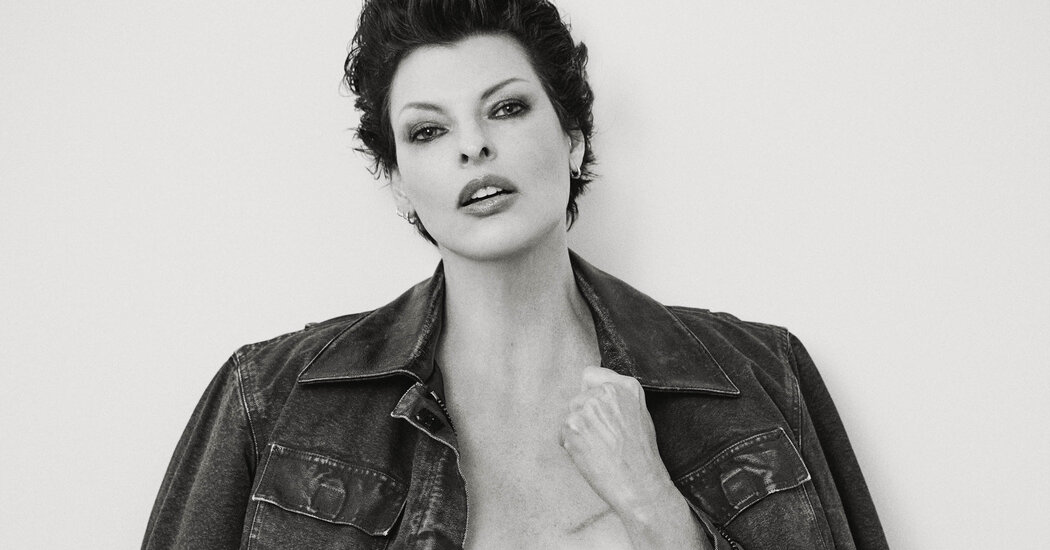When Steven Meisel shot the supermodel Linda Evangelista for the September 2022 issue of British Vogue, she hid many of her features beneath a series of hats and scarves. The year before, she had filed a lawsuit after a cosmetic procedure left her “disfigured,” she said, and reluctant to venture outdoors.
Ms. Evangelista, 58, seems far less shy these days. She has since been on other Vogue covers and in a television series, and has talked openly about being treated for breast cancer twice. This month, she flaunted her face, frame and a mastectomy scar on the cover of Zeit Magazin, a sister publication of the German weekly Die Zeit, which has an English edition.
In the magazine, Ms. Evangelista appears in photos by Cass Bird looking not much older than she did in the ’90s, when she bragged that she would not get out of bed for less than $10,000 a day. On the cover, she looks sultry in a denim jacket unfastened to the waist, and inside she appears positively coltish, her skin as youthful as a girl’s.
“I try to love myself as I am,” she said in an interview with Claire Beermann, a writer and the style director at Zeit Magazin. (Ms. Evangelista declined to be interviewed for this article through a representative.)
Visible scar aside, the photos tell a different story. In the interview, Ms. Evangelista said her features had been pulled taut with rubber bands and tape for the photo shoot, explaining that fashion is about selling illusions. One may be her sense of self-love.
Near the end of the interview, she and Ms. Beermann posed for a selfie, the writer recalled. Ms. Evangelista closely inspected the result. “Oh, God,” she lamented to Ms. Beermann. “In this bright light, you can see every pore.”
A New Frontier for Fashion Imagery
Art made using artificial intelligence is often reviled: It lacks honesty and creativity, some say, not to mention flouts copyright laws. But others, like Rupert Cresswell, an advertising and animation creative director in Los Angeles, argue that A.I. can be used to create works intended as a corrective to a “world that can be a pretty grim place,” as Mr. Cresswell put it.
That’s how he sees the books of stridently colorful A.I.-generated imagery he recently released. The two volumes, called “Frontier Drops,” include images of ranchers and wranglers he made using programs like Midjourney and Photoshop. He has shared many of those images on Instagram, where he goes by Prospex Park.
His cowboys and cowgirls exist in a radically inclusive universe. They come in varying shapes and skin tones, their costumes lavishly quilted and embroidered, their portraits familiar looking yet alien. Mr. Cresswell, who is in his 40s and who identifies as queer, said the images offered “pure escapism” and reflected his aim “to approach some Western tropes with a modern look and through a queer lens.”
His timing, he knows, is serendipitous. The books’ releases coincide with a resurgence of cowboy style. The aesthetic has been revisited by Pharrell Williams, who put a Western spin on his fall 2024 men’s collection for Louis Vuitton, and by Beyoncé, who has adopted a Stetson and spurs to promote “Texas Hold ’Em,” her new chart-topping country single.
And the style may be further explored by Mr. Cresswell, who said some people had expressed interest in bringing his machine-generated images to life. “We’ll see what happens,” he said.
A Fashion Show That’s Not About Clothes
“The New Look,” a new dramatic series on Apple TV+, follows Christian Dior (played by Ben Mendelsohn) and his design-world contemporaries in Paris during World War II. But couture devotees who tune in may be surprised to notice there is precious little fashion in the early episodes.
It comes mostly in teasing glimpses: A few scenes feature Dior’s gowns and his famous Bar suit with its cinched waist and swirling calf-length skirt. Others show the occasional length of tulle wafting over his cutting table.
What viewers get instead is a mostly sympathetic peek into the interior lives and unlikely relationships forged among Dior and designers like Coco Chanel (Juliette Binoche), Cristóbal Balenciaga (Nuno Lopes) and Pierre Balmain (Thomas Poitevin) during the darkest days of the Nazi occupation of France.
The camaraderie among Dior, Balenciaga and Balmain is startlingly tender, particularly in a scene where, over drinks, they mourn prewar Paris and argue about whether to make gowns for Nazis’ wives and girlfriends. Balenciaga claims the moral high ground and exits in a huff.
As a friend, though, Balenciaga is steadfast. In a bittersweet scene, he tries to soothe a distraught Dior with a bit of Swiss chocolate. “One half for you and one half for me,” he says. “To the end of this Nazi awfulness.”
Were the two designers all that collegial in real life? Yes, for the most part. In “The Master of Us All: Balenciaga, His Workrooms, His World,” the author Mary Blume writes that while he and Dior may not have been the tightest of chums, they did share a lasting friendship.







